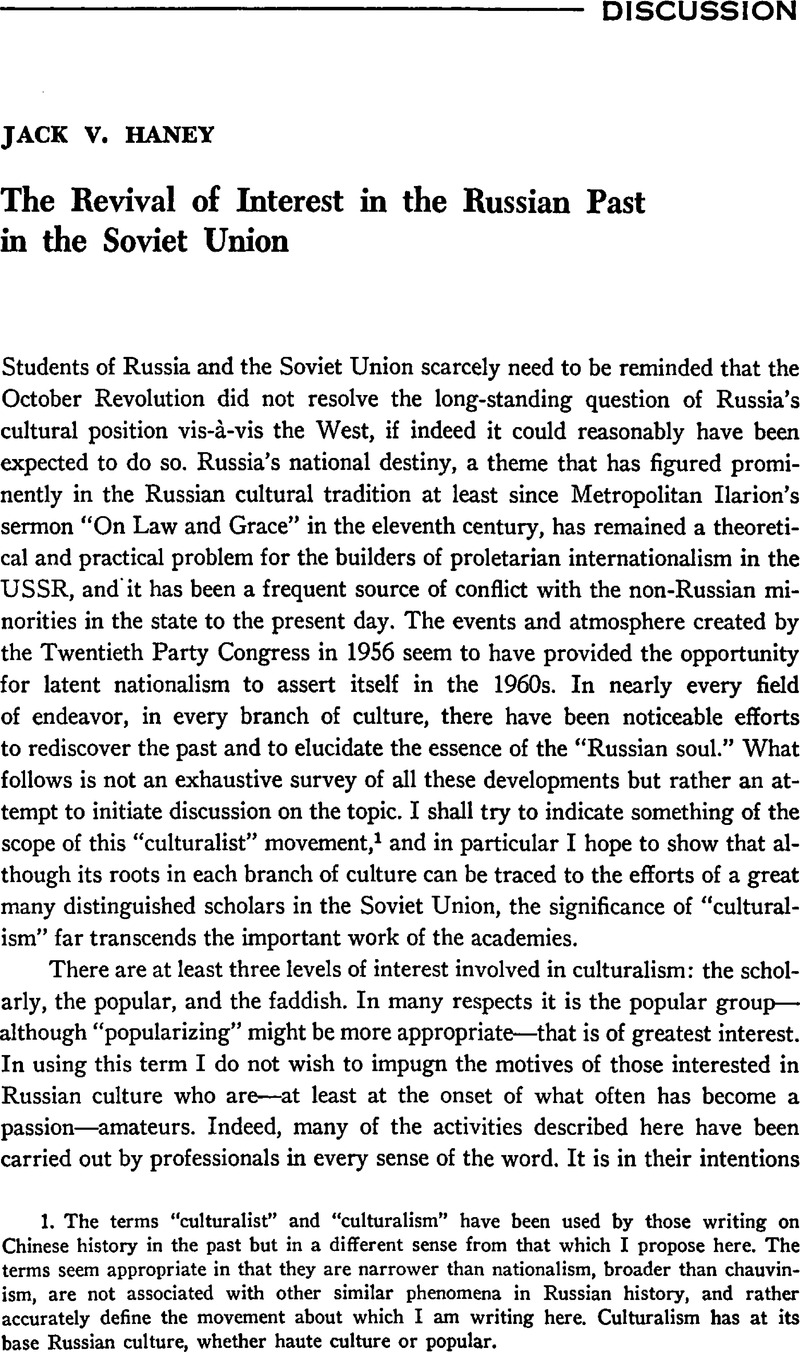Published online by Cambridge University Press: 27 January 2017

1. The terms “culturalist” and “culturalism” have been used by those writing on Chinese history in the past but in a different sense from that which I propose here. The terms seem appropriate in that they are narrower than nationalism, broader than chauvinism, are not associated with other similar phenomena in Russian history, and rather accurately define the movement about which I am writing here. Culturalism has at its base Russian culture, whether haute culture or popular.
2. See Georgie Anne Geyer, “A New Quest for the Old Russia,” Saturday Review, Dec. 25, 1971, p. 16.
3. Efim Dorosh, “Obrazy Rossii,” Novyi mir, 1969, no. 3, p. 182.
4. “Tysiacheletnie korni russkoi kul'tury,” Molodaia gvardiia, 1968, no. 9, p. 2S4.
5. Dorosh, “Obrazy Rossii,” p. 182.
6. Tarasenkova, N, “Za vologodskoi starinoi … : Ocherk,” Novyi mir, 1969, no. 4, pp. 105–20.Google Scholar
7. See particularly Vladimir Soloukhin, “Pis'ma iz Russkogo muzeia,” in Molodaia gvardiia, 1966, nos. 9 and 10, and “Chernye doski : Zapiski nachinaiushchego kollektsionera, “ Moskva, 1969, no. 1, pp. 129-87.
8. “Tysiacheletnie korni russkoi kul'tury,” p. 256.
9. See, for example, Iakovlev, K, “Tiagotenie ili otiagoshchenie?” Molodaia gvardiia, 1968, no. 9, pp. 290–99.Google Scholar
10. This is, in fact, the second edition of Galaktionov and Nikandrov's book. The first, published in 1961, embraced a much more rigid, tendentious, Marxist-Leninist approach.
11. See also the recent book by N. A. Demina, Andrei Rublev i khudozhniki ego kruga (1972).
12. Dedkov, I, “Stranitsy derevenskoi zhizni (Polemicheskie zametki),” Novyi mir, 1969, no. 3, pp. 232, 242.Google Scholar
13. Iunosf′, 1968, no. 2, p. 99.
14. Chalmaev, V, “Velikie iskaniia,” Molodaia gvardiia, 1968, no. 3, pp. 270–95Google Scholar, and “Neizbezhnosf',” Molodaia gvardiia, 1968, no. 9, pp. 259-89.
15. Chalmaev, “Velikie iskaniia,” p. 278.
16. Ibid., p. 293.
17. Chalmaev, “Neizbezhnosf',” p. 264.
18. Ibid., pp. 267-68.
19. Iurii Surovtsev, “Pridumannaia neizbezhnost',” Literaturnaia Rossiia, Nov. 7, 1968, p. 17, quoting Chalmaev, “Neizbezhnost',” p. 281.
20. Surovtsev, “Pridumannaia neizbezhnost',” p. 17.
21. Dedkov, “Stranitsy derevenskoi zhizni,” pp. 231-32.
22. Anatolii, Lanshchikov, “Ostorozhno—kontseptsiia I (Polemicheskie zametki),” Molodaia gvardiia, 1969, no. 2, pp. 275–97Google Scholar, esp. pp. 280-89; A. Metchenko, “Sovremennoe i vechnoe,” Moskva, 1969, no. 1, pp. 198-211, esp. pp. 202-6. For Dementiev's article see Dement'ev, A., “O traditsiiakh i narodnosti (Literaturnye zametki),” Novyi mir, 1969, no. 4, pp. 215–35Google Scholar
23. Mikhail Alekseev, Sergei Vikulov, Sergei Voronin, Vitalii Zakrutkin, Anatolii Ivanov, Sergei Malashkin, Alexander Prokofiev, Peter Proskurin, Sergei Smirnov, Vladimir Chivilikhin, and Nikolai Shundik.
24. In the last eighteen months articles have appeared by Belov, Vasilii (“Eshche raz o iazyke,” Molodaia gvardiia, 1971, no. 6, pp. 270–71Google Scholar) and Vikulov, Sergei (“O derevne i ‘derevenshchikakh, ’;” Molodaia gvardiia, 1971, no. 6, pp. 276–77Google Scholar), poetry on culturalist themes by Vikulov Molodaia gvardiia, 1972, no. 6, pp. 13-19), and an extremely favorable review of the latest volume of the culturalist poet Nikolai Rubtsov, Zelenye tsvety, published posthumously in 1971 and reviewed by M. Lobanov in Molodaia gvardiia, 1972, no. 6, pp. 290-95.
25. On the study of Old Russian literature since 1917 see Ia. S. Lur'e, “Drevnerusskaia literatura,” in V. G. Bazanov, ed., Sovetskoe literaturovedenie za 50 let (Leningrad, 1968). The introduction to this book by G. M. Fridlender covers literature and the arts in general. The work is remarkable for the openness with which it discusses the problems faced by scholars and writers from time to time in the Soviet Union.
26. One might note the excellent works by A. I. Klibanov in this connection, particularly his Istoriia religioznogo sektantstva v. Rossii (60-e gody XIX V.-1917 g.) (Moscow, 1965).
27. Vladimir, Soloukhin, Searching for Icons in Russia, trans. Falla, P. S. (New York, 1971), pp. 13–14.Google Scholar This is the English translation of his “Chernye doski” (“Black Boards“).
28. Ibid., p. 73.
29. Ibid., p. 74.
30. Literaturnaia Rossiia, Mar. 17, 1967. See also the poem by Rimma Kozakova published in Smena, 1967, no. 1, and the one by Valentin, Sidorov, “Sluchai na vystavke,” in Molodaia gvardiia, 1967, no. 8, pp. 63–64.Google Scholar
31. Nicholas, Berdyaev, Dostoevsky, trans. Attwater, Donald (Cleveland and New York, 1969), p. 136.Google Scholar